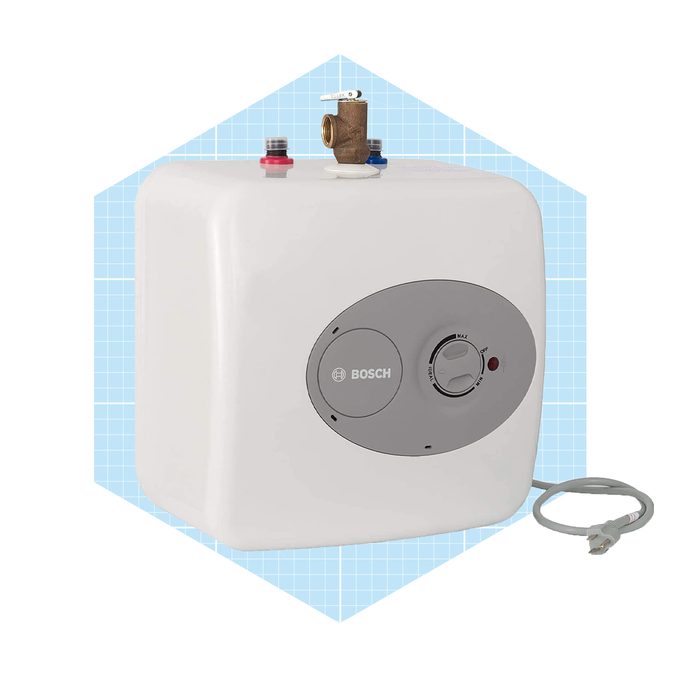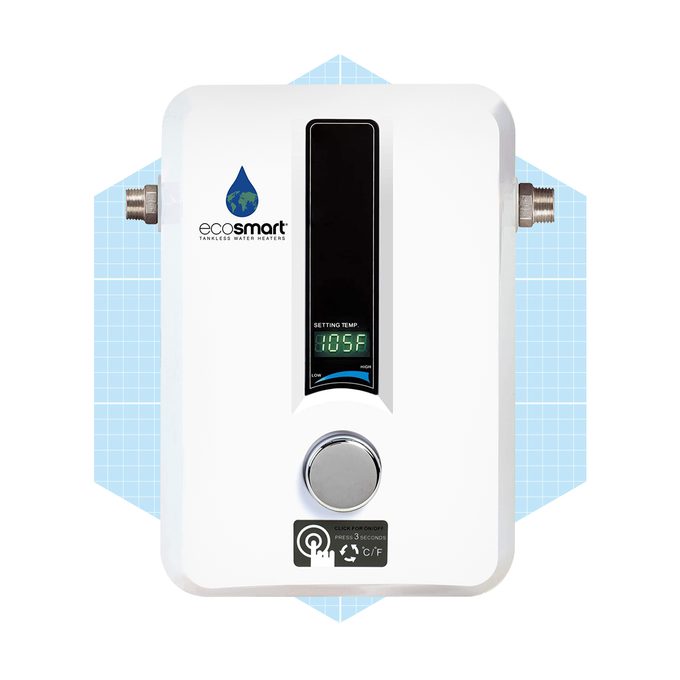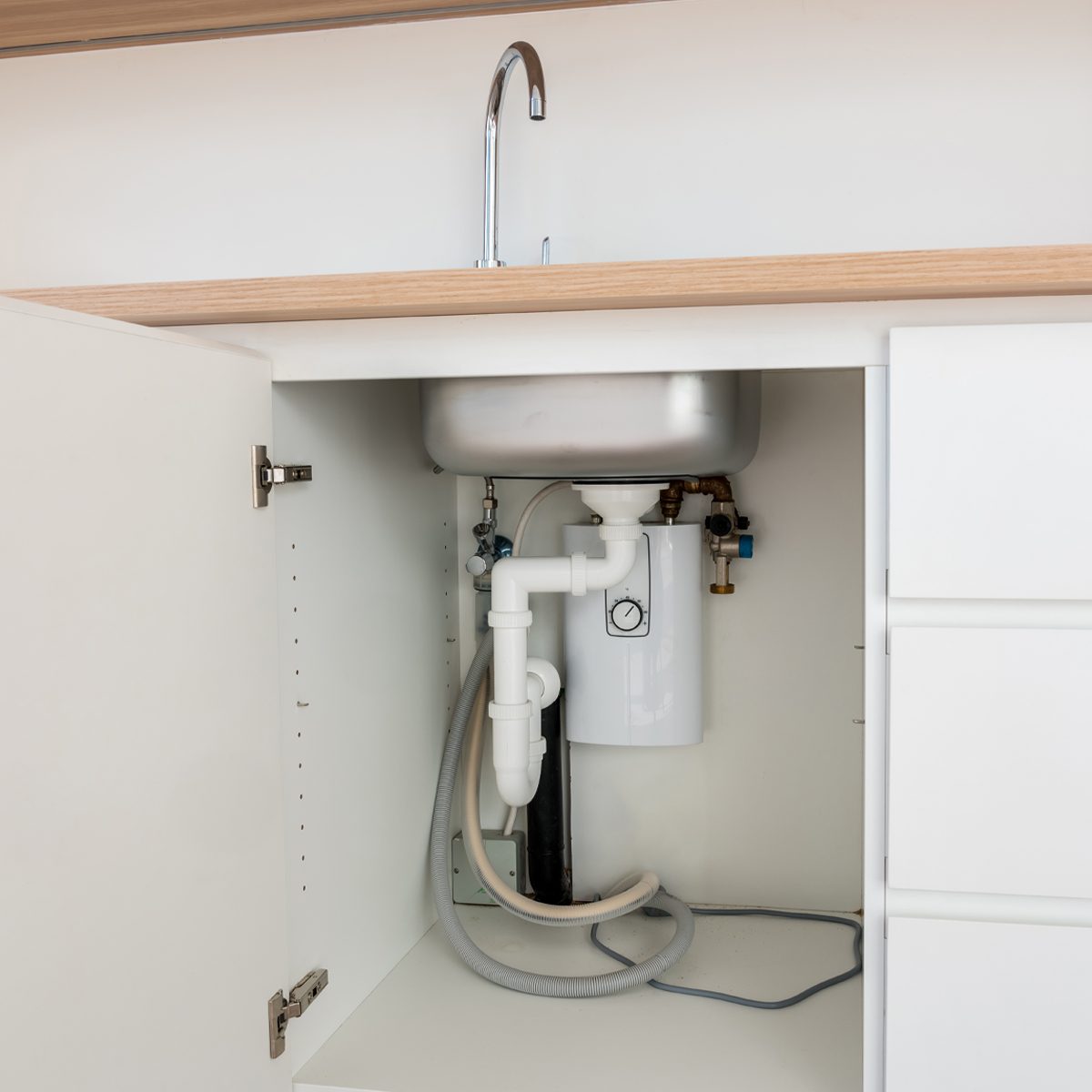One of the things I liked about living in Japan 20 years ago was the on-demand water heater that supplied the kitchen sink. Turn it on, and you had instant hot water for doing dishes, cooking, washing, etc. On-demand kitchen water heaters were common household fixtures and even considered necessary appliances.
If you want that kind of convenience in North America, your best bet is to buy an under-sink water heater. We call these types of heaters “point-of-use” because they are only intended to serve a single fixture at that fixture’s location, says Jessie Cannizzaro, a master plumber and owner of Milestone Plumbing.
But if you already have a central water heater, isn’t an under-sink water heater redundant? Maybe, if the distance between the main water heater and the sink is short. But if it isn’t, the under-sink water heater can be a water-saving asset.
Consider this: If the flow rate from your faucet is two gallons per minute (which is common) and you have to wait 30 seconds for hot water, you waste a gallon of water every time. If you use hot water three times a day, you could be dumping 600 gallons down the drain every month. An under-sink water heater can prevent that.
You can choose a tank or tankless model. The latter offers a choice of two voltages. Here are our picks for the best options on the market.
Best Under-Sink Water Heaters
 via merchant
via merchant
via merchant
via merchant
Pros:
-
Provides hot water quickly
-
Lightweight, compact design
-
Affordable
-
Easy to install
-
Premium glass-lined material for a long service life
Cons:
-
Some customers reported issues with leakage
Though the Bosch Tronic 3000 is compact and fits easily in small spaces, it holds four gallons, more than most similar water heaters. It has a glass-lined tank for added durability and thick CFC-free foam insulation for maximum energy efficiency. A long power cord plugs into a 120-volt outlet for independent installation or in line with a large hot water source. For added convenience, it can be mounted on a floor or the wall.
Dimensions: 13.75 by 13.75 by 13.5 in. | Weight: 17.3 lbs. | Power source: Electric
 via merchant
via merchant
via merchant
via merchant
Pros:
-
Mounts in any orientation for a flexible installation
-
Compact size fits almost anywhere
-
Silent operation
-
Control system activates heater only on demand
-
High temperature limit switch enables safe operation
Cons:
-
Only includes a one-year warranty on parts
This Eemax electric model weighs just under four pounds and can be mounted on the side of a reasonably large cabinet. This tankless water heater draws 3,000 watts at 120 volts, a significant amount of power. Remember: It’s only on when the water’s running. If you already have a power outlet for your garbage disposal, you can plug this unit into it.
Dimensions: 9.75 by 5.25 by 3 in. | Weight: 3.94 lbs. | Power source: Electric
 via merchant
via merchant
via merchant
via merchant
Pros:
-
Compact size saves valuable space under the sink
-
Digital control allows you to set your temperature in increments of one degree
-
Limited lifetime warranty
-
No venting required
-
Energy-efficient
Cons:
-
Must be connected to a 60-amp double-pole breaker
The EcoSmart Eco 11 Tankless Water Heater provides a flow between 1.3 and 3.1 gallons per minute, depending on the incoming water temperature. The unit measures 11-1/2- by 8- by 3-1/2-in. and can fit inside the sink cabinet or on the wall next to the sink. This energy-efficient unit features advanced self-modulating technology, which only heats the water when you need it.
Dimensions: 7.9 by 11.4 by 3.7 in. | Weight: 6.5 lbs. | Power source: Electric
Types of Under-Sink Water Heaters
Under-sink water heaters are all electric, but vary in several ways:
Tank vs. tankless: Tank-style units hold a ready supply of hot water, but may have to cycle on occasionally to keep it warm. A tankless on-demand model comes on only when there’s water demand and typically consumes more power when it’s on than a tank-style model.
Voltage: These water heaters come in 120- and 240-volt models. Because they need more instantaneous power, many require 240 volts, while tank-style models often need only 120 volts. Models that operate at the lower voltage usually have plugs, while those at the higher voltage are hardwired.
Standing vs. hanging: Tank-style water heaters typically rest on the bottom of the cabinet, whereas on-demand models hang from the side.
What to Look for When Buying an Under-Sink Water Heater
When purchasing an under-sink water heater, it is crucial to consider several key factors. Cannizzaro outlines the essential considerations:
Sizing:
- For optimal performance, carefully review the sizing chart provided for point-of-use and tankless water heaters.
- Identify the unit that can deliver the required gallons per minute (gpm) to achieve the desired temperature rise for your water usage.
- Larger heaters may be necessary in areas with significantly lower ground temperatures to ensure the appropriate temperature rise and adequate pressure for fixtures.
Climate:
- Contrary to a common misconception, under-sink water heaters may not be practical for serving multiple fixtures, especially in colder climates.
- The more the groundwater temperature needs to be raised, the lower the gpm of hot water the heater can produce. This affects the heater’s ability to support plumbing systems effectively.
Power availability:
- Consider the available power supply for the under-sink water heater, and consult with an electrician to determine compatibility.
- Ensure the selected models align with the available electrical infrastructure to avoid issues with installation and functionality.
Drain receptor:
- Some models are equipped with a temperature and pressure relief valve, which, per most codes, requires a designated receptor for proper discharge.
- Proactively assess this requirement to plan for installation and compliance with local codes.
Why Trust Us
With more than 30 years working in the building trades, I used my hands-on experience and firsthand knowledge to select the best under-the-sink water heaters. I’ve contributed to constructing a city in the Oregon desert and worked as a carpenter, plumber and furniture refinisher, just to name a few of my qualifications. Since 2010, I’ve been sharing my expertise through DIY articles and serving as an online consultant, including with Home Depot’s Pro Referral service. My practical insights have also been published on platforms like Landlordology, Apartments.com and Hunker, establishing me as a trusted source for reliable home improvement advice.
I consulted Jessie Cannizzaro, a master plumber who owns Milestone Plumbing, a residential and small commercial plumbing business, for this piece. She started the company in 2011 in her Wauwatosa, Wisconsin basement and garage. She grew up joining her dad on the job at his plumbing company, learning to solder at the age of 7. Cannizzaro’s passion for the business continued to develop over the years through apprenticeship and after earning her bachelor’s and MBA at UW-Milwaukee. Besides supervising 16 employees, she advocates for multiple organizations that encourage high school students to enter the trades. She also created a coloring book to introduce elementary-aged kids to the joys of being a plumber.
Caitlyn Fitzpatrick, an editor and writer since 2014 and a content strategist in the commerce journalism word since 2017, helped update this piece.
FAQs
What is an under-sink water heater?
An under-sink water heater, aka a point-of-use water heater, is a small version of a whole-house water heater, providing instant hot water at the sink. Because they’re made for cramped quarters, tank-style under-sink water heaters have limited storage capacity—usually from 2.5 to 4 gallons. The flow rate depends on the main plumbing, but most can handle up to 3 gallons per minute.
Under-sink water heaters can be connected to the main hot or cold water supply. When the water heater is the sole source of hot water, it’s connected to the cold supply. However, when it expedites hot water availability, it’s typically linked to the hot supply.
How much does an under-sink water heater cost?
Prices range from $50 to $300, not including installation, which runs $100 to $200 depending on the plumber’s hourly rate. There will also be a few extras, such as supply hoses (inexpensive) and a new electric circuit under the sink if one isn’t available (costly).
Are under-sink water heaters worth it?
Instant hot water from under-sink heaters has both benefits and drawbacks. On the positive side, they reduce water wastage, are convenient for cooking and cleaning, are inexpensive and easy to install and require low- to no-maintenance. However, you may face a higher electric bill, reduced storage space under the sink, fluctuating water temperature, particularly with on-demand models, and limited supply of hot water, particularly with tank-style models.
How do you install an under-sink water heater?
You can DIY an under-sink water heater installation if you have basic plumbing skills, but there are two prerequisites: adequate space in the under-sink cabinet and a power source. If you need to remodel the cabinet, you can do that yourself. But you’ll probably need to hire an electrician if you need a new electric circuit. Once you meet the necessary conditions, proceed with the following installation steps:
- Position the device in place, setting it on a solid base or hanging from brackets.
- Disconnect the hot water supply from the faucet and connect it to the water heater inlet.
- Connect the faucet to the water heater outlet.
- Plug in the unit or hardwire it.
If the sink only has a cold water supply, install a tee in the pipe so you can branch it. One branch goes to the faucet, and one goes to the water heater, which in turn connects to the faucet with a separate hose.
Which is better, tankless or tank under-sink water heater?
There are pros and cons to both types of heaters. A tankless under-sink water heater runs more efficiently, however, they’re more expensive to install and require more regular maintenance. A tank under-sink water heater has less upfront cost, however, it only stores a certain amount of hot water at a time as opposed to the seemingly “endless” amount from a tankless model.
How to Choose the Perfect Water Heater
From tankless to traditional models, our expert tips will help you find the right water heater for your home and budget.





















